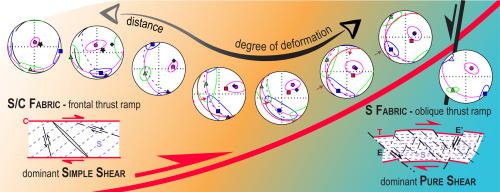当前位置:
X-MOL 学术
›
Tectonophysics
›
论文详情
Our official English website, www.x-mol.net, welcomes your feedback! (Note: you will need to create a separate account there.)
Magnetic fabric in carbonatic rocks from thrust shear zones: A study from the Northern Apennines (Italy)
Tectonophysics ( IF 2.9 ) Pub Date : 2020-09-01 , DOI: 10.1016/j.tecto.2020.228573 Sara Satolli , Claudio Robustelli Test , Dorota Staneczek , Elena Zanella , Fernando Calamita , Evdokia Tema
Tectonophysics ( IF 2.9 ) Pub Date : 2020-09-01 , DOI: 10.1016/j.tecto.2020.228573 Sara Satolli , Claudio Robustelli Test , Dorota Staneczek , Elena Zanella , Fernando Calamita , Evdokia Tema

|
Abstract We present the results of an integrated structural and anisotropy of magnetic susceptibility (AMS) investigation in calcareous and marly rocks from thrust shear zones. A total of 17 sites from six localities along the frontal and oblique ramp of the Olevano-Antrodoco-Sibillini thrust and back thrust (Northern Apennines, Italy) were studied to investigate both magnetic fabric and structural characteristics of Cretaceous to Neogene calcareous and marly rocks. In most of the sites AMS is controlled by the paramagnetic minerals (prevailingly phyllosilicates), with minor contribution of ferromagnetic (sensu latu) ones. Structural analysis shows the presence of SC- and S-tectonites associated to predominant simple and pure shear, respectively. The combination of density diagrams and cluster analysis allowed discriminating the contributions of sedimentary and tectonic processes to the bulk magnetic fabric. Six different subfabrics were distinguished, related to the structural data and associated to deformation stages and regimes: A. sedimentary fabric; B. intersection lineation; C. magnetic foliation parallel to S planes with k1 parallel to the S/C intersection; D. k1 moving toward the slip vector; E. magnetic foliation parallel either to the S or the C planes, with k1 parallel to the slip vector or the transport direction; F. k1 parallel to extensional planes intersection. The magnetic foliation has a double tendency to parallelize to pressure solution cleavage (S) and shear planes (C), while the magnetic lineation tends to progressively align with the slip vector, except for pure-shear-dominated sites at less than 15–20 cm from the thrust, where it aligns with the transport direction. The magnetic fabric is dominated by simple shear deformation. The protocol applied for AMS analysis shows a great potential to unravel mixed sedimentary and/or tectonic features in magnetic fabrics. AMS can be considered as a useful tool in unravelling the variation of simple-pure shear deformation regime in shear zones.
中文翻译:

来自逆冲剪切带的碳酸盐岩中的磁性结构:来自北亚平宁山脉的研究(意大利)
摘要 我们介绍了对冲断剪切带的钙质岩和泥质岩的磁化率 (AMS) 综合结构和各向异性研究的结果。研究了沿着 Olevano-Antrodoco-Sibillini 逆冲断层和逆逆冲断层(意大利北部亚平宁山脉)的前缘和斜斜坡的 6 个地点的 17 个地点,以研究白垩纪至新近纪钙质岩和泥灰岩的磁性结构和结构特征。在大多数地点,AMS 由顺磁性矿物(主要是页硅酸盐)控制,铁磁性(sensu latu)矿物的贡献很小。结构分析显示 SC 和 S 构造岩的存在分别与主要的简单和纯剪切相关。密度图和聚类分析相结合,可以区分沉积和构造过程对大块磁性结构的贡献。区分了六种不同的亚结构,与结构数据相关,并与变形阶段和状态相关: A. 沉积结构;B. 交叉线划线;C. 磁叶理平行于 S 平面,k1 平行于 S/C 交叉点;D. k1 向滑移矢量移动;E. 磁叶理平行于 S 或 C 平面,k1 平行于滑移矢量或传输方向;F. k1 平行于伸展平面相交。磁性叶理具有与压力溶液解理 (S) 和剪切平面 (C) 平行的双重趋势,而磁性线条倾向于与滑移矢量逐渐对齐,除了距推力小于 15-20 厘米的纯剪切主导站点,在那里它与运输方向对齐。磁性织物以简单的剪切变形为主。应用于 AMS 分析的协议显示出解开磁性织物中混合沉积和/或构造特征的巨大潜力。AMS 可以被认为是解开剪切带中简单-纯剪切变形状态变化的有用工具。
更新日期:2020-09-01
中文翻译:

来自逆冲剪切带的碳酸盐岩中的磁性结构:来自北亚平宁山脉的研究(意大利)
摘要 我们介绍了对冲断剪切带的钙质岩和泥质岩的磁化率 (AMS) 综合结构和各向异性研究的结果。研究了沿着 Olevano-Antrodoco-Sibillini 逆冲断层和逆逆冲断层(意大利北部亚平宁山脉)的前缘和斜斜坡的 6 个地点的 17 个地点,以研究白垩纪至新近纪钙质岩和泥灰岩的磁性结构和结构特征。在大多数地点,AMS 由顺磁性矿物(主要是页硅酸盐)控制,铁磁性(sensu latu)矿物的贡献很小。结构分析显示 SC 和 S 构造岩的存在分别与主要的简单和纯剪切相关。密度图和聚类分析相结合,可以区分沉积和构造过程对大块磁性结构的贡献。区分了六种不同的亚结构,与结构数据相关,并与变形阶段和状态相关: A. 沉积结构;B. 交叉线划线;C. 磁叶理平行于 S 平面,k1 平行于 S/C 交叉点;D. k1 向滑移矢量移动;E. 磁叶理平行于 S 或 C 平面,k1 平行于滑移矢量或传输方向;F. k1 平行于伸展平面相交。磁性叶理具有与压力溶液解理 (S) 和剪切平面 (C) 平行的双重趋势,而磁性线条倾向于与滑移矢量逐渐对齐,除了距推力小于 15-20 厘米的纯剪切主导站点,在那里它与运输方向对齐。磁性织物以简单的剪切变形为主。应用于 AMS 分析的协议显示出解开磁性织物中混合沉积和/或构造特征的巨大潜力。AMS 可以被认为是解开剪切带中简单-纯剪切变形状态变化的有用工具。



























 京公网安备 11010802027423号
京公网安备 11010802027423号